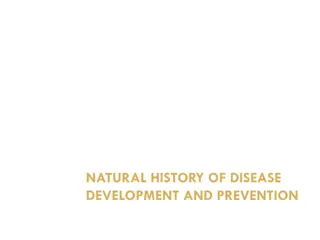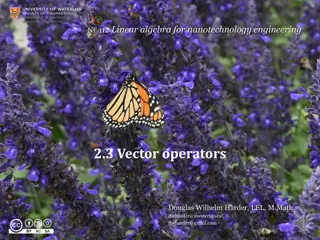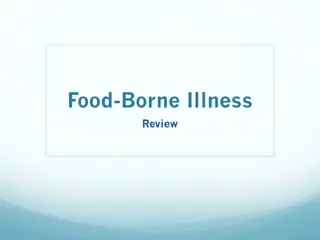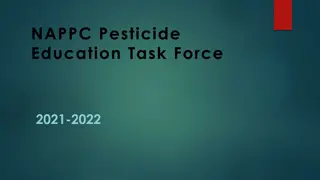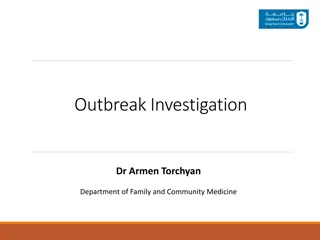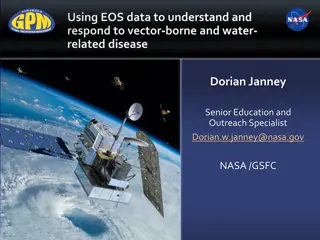National Vector Borne Disease Control Program Overview
The National Vector Borne Disease Control Program (NVBDCP) focuses on preventing and controlling diseases such as Malaria, Dengue, Chikungunya, Filariasis, Japanese Encephalitis, and Kala-azar. Implemented at state level, NVBDCP aims to eliminate these diseases through strategic planning, policy making, and effective program implementation under NHM. Targeted elimination goals include phased malaria elimination by 2030 and reducing cases of Filariasis and Kala-azar. Strategies involve early diagnosis, complete treatment, vector control measures, surveillance, case management, and inter-sectoral coordination.
Download Presentation

Please find below an Image/Link to download the presentation.
The content on the website is provided AS IS for your information and personal use only. It may not be sold, licensed, or shared on other websites without obtaining consent from the author.If you encounter any issues during the download, it is possible that the publisher has removed the file from their server.
You are allowed to download the files provided on this website for personal or commercial use, subject to the condition that they are used lawfully. All files are the property of their respective owners.
The content on the website is provided AS IS for your information and personal use only. It may not be sold, licensed, or shared on other websites without obtaining consent from the author.
E N D
Presentation Transcript
NVBDCP presentation for orientation for PS/MDs
Introduction National Vector Borne Disease Control Program (NVBDCP) is implemented in the States/UTs for prevention and control of vector borne diseases (VBDs) namely Malaria, Dengue, Chikungunya, Filariasis, Japanese Encephalitis (JE) and Kala- azar The Directorate of NVBDCP is the nodal agency for planning, policy making, technical guidance and monitoring and evaluation of program implementation in respect of prevention and control of these vector borne diseases under the overall umbrella of NHM. Dengue, Chikungunya and JE are known as outbreak prone VBDs
VBDs & its Elimination Target Sr No 1 Disease Caused by Target year for elimination Malaria Anopheles mosquito 2030 (in phased manner) Cat-I(15 states/UTs) by 2020 Cat-II(11states/UTs) by 2022 Cat-III(10 states/UTs) by 2020 Culex quinquefasciatus Sandfly 2021 (Mf rate <1) 2 Lymphatic Filariasis Kala-azar 2020 (< I case per 10,000 population) 3 Dengue Aedes mosquito 4 Chikunguny a Japanese Encephalitis Aedes mosquito 5 Culex 6
Strategy for prevention & control of Malaria: Early diagnosis and complete treatment Vector Control Strategies (Indoor Residual Spray (IRS), LLINs, fish, chemical and bio- larvicide, source reduction) Supportive intervention including behaviour change communication (BCC), public private partnership and inter- sectoral convergence, human resource development through capacity building, operational research
Strategies for prevention & control of Dengue & Chikungunya Surveillance - Disease and Entomological Surveillance Case management - Laboratory diagnosis and Clinical management Vector management - Environmental management for Source Reduction, Chemical control, Personal protection and Legislation Outbreak response - Epidemic preparedness and Media management Capacity building - Training, strengthening human resource and Operational research Behaviour Change Communication - Social mobilization and Information Education and Communication (IEC) Inter-sectoral coordination - Health, Urban Development, Rural Development, Panchayati Raj, Surface Transport and Education sector Monitoring and Supervision - Analysis of reports, review, field visit and feedback
Strategies for elimination of Kala-Azar Parasite elimination and disease management Early case detection and complete treatment. Strengthening of referral; Integrated vector control Indoor Residual Spraying (IRS), Environmental management by maintenance of sanitation and hygiene and provision of pucca houses in Kala-azar affected villages PMAY-G. Supportive interventions Behaviour Change Communication for social mobilization, Inter-sectoral convergence, Capacity building by training and Monitoring and Evaluation.
Elimination Strategies for Lymphatic Filariasis Twin pillar strategy adopted for elimination. Annual Mass Drug Administration Morbidity Management & Disability Prevention (MMDP) Implementation of Triple Drug Therapy(IDA(Ivermectin+DEC+Albendazole))
Strategies for prevention & control of Japanese Encephalitis JE Vaccination Disease and vector surveillance Laboratory diagnosis through sentinel sites in government/private medical colleges and hospitals Case management Capacity building BCC/IEC




